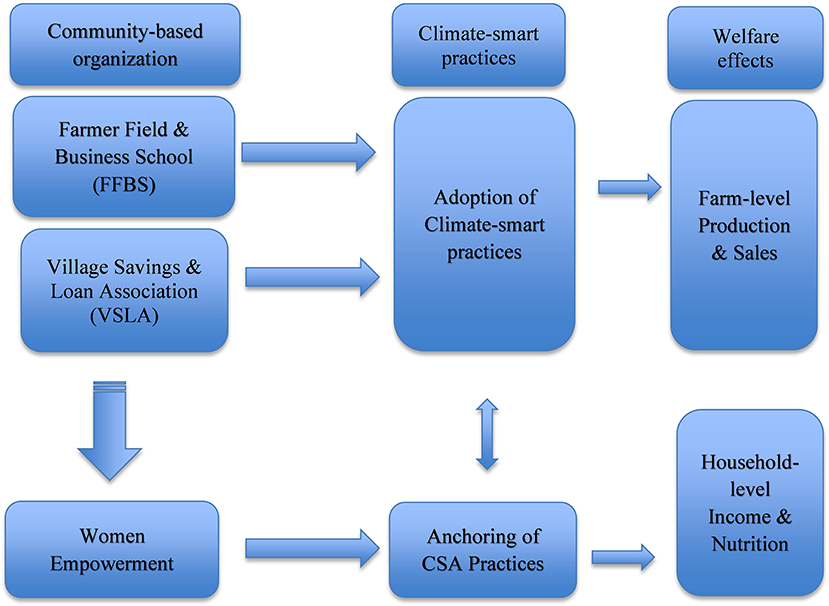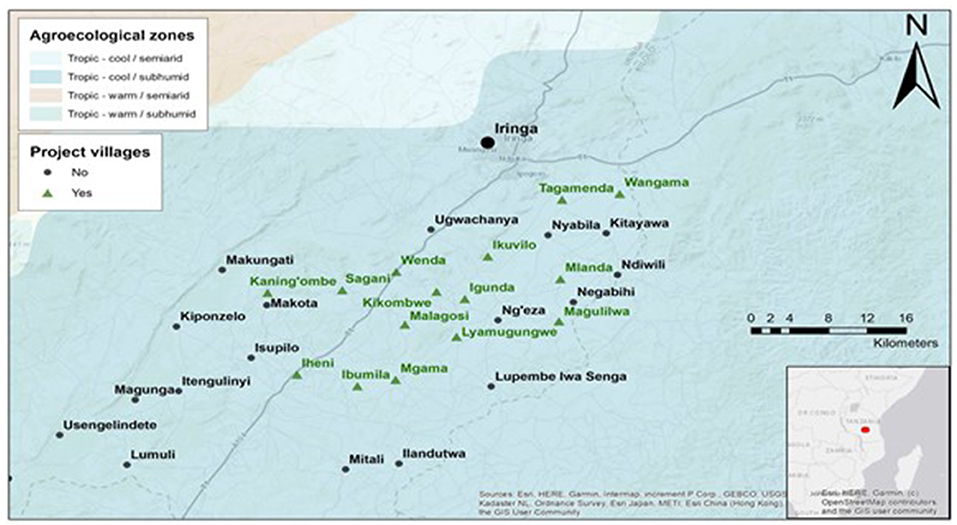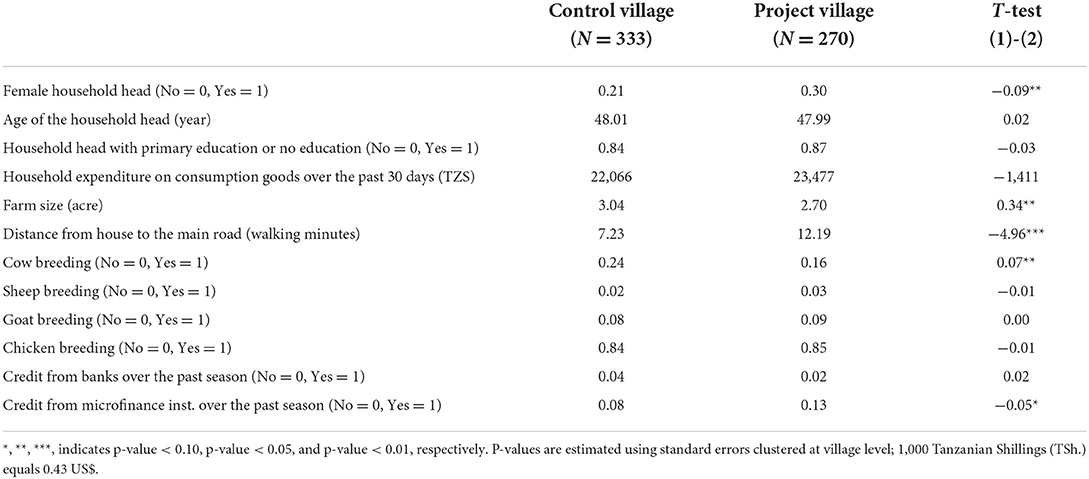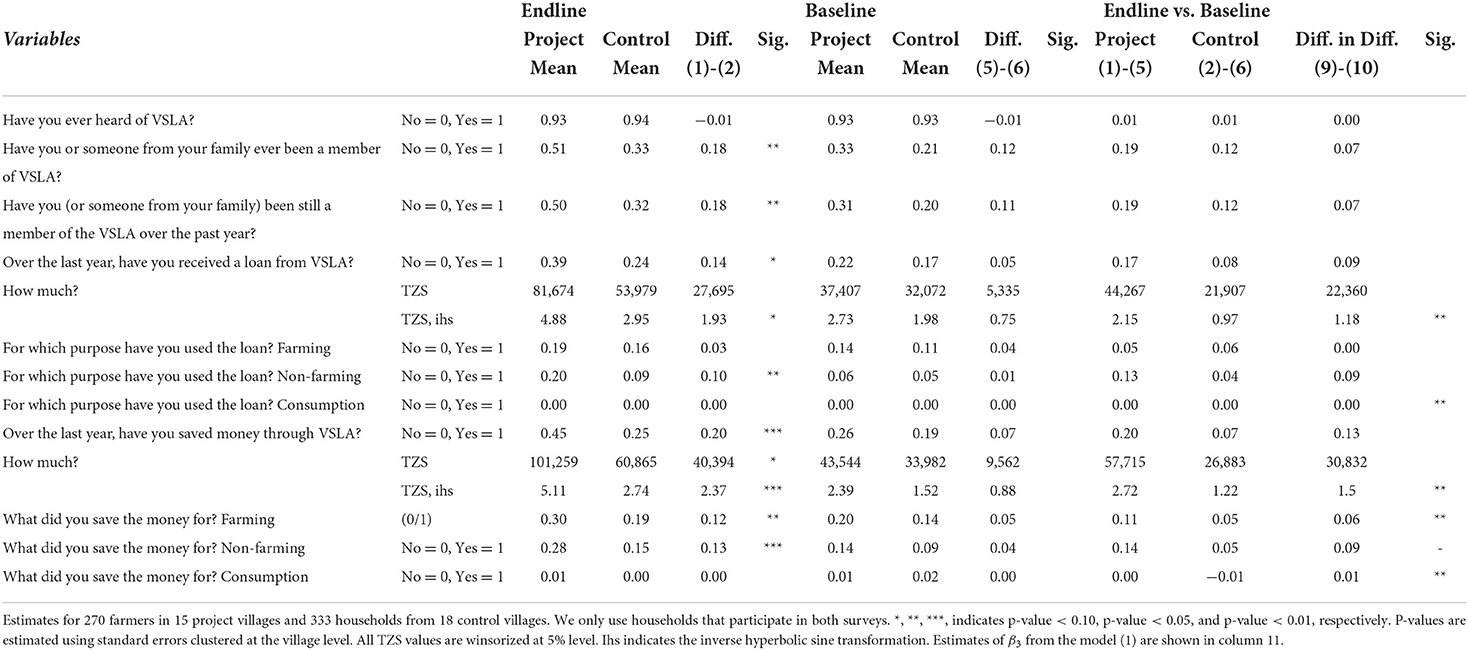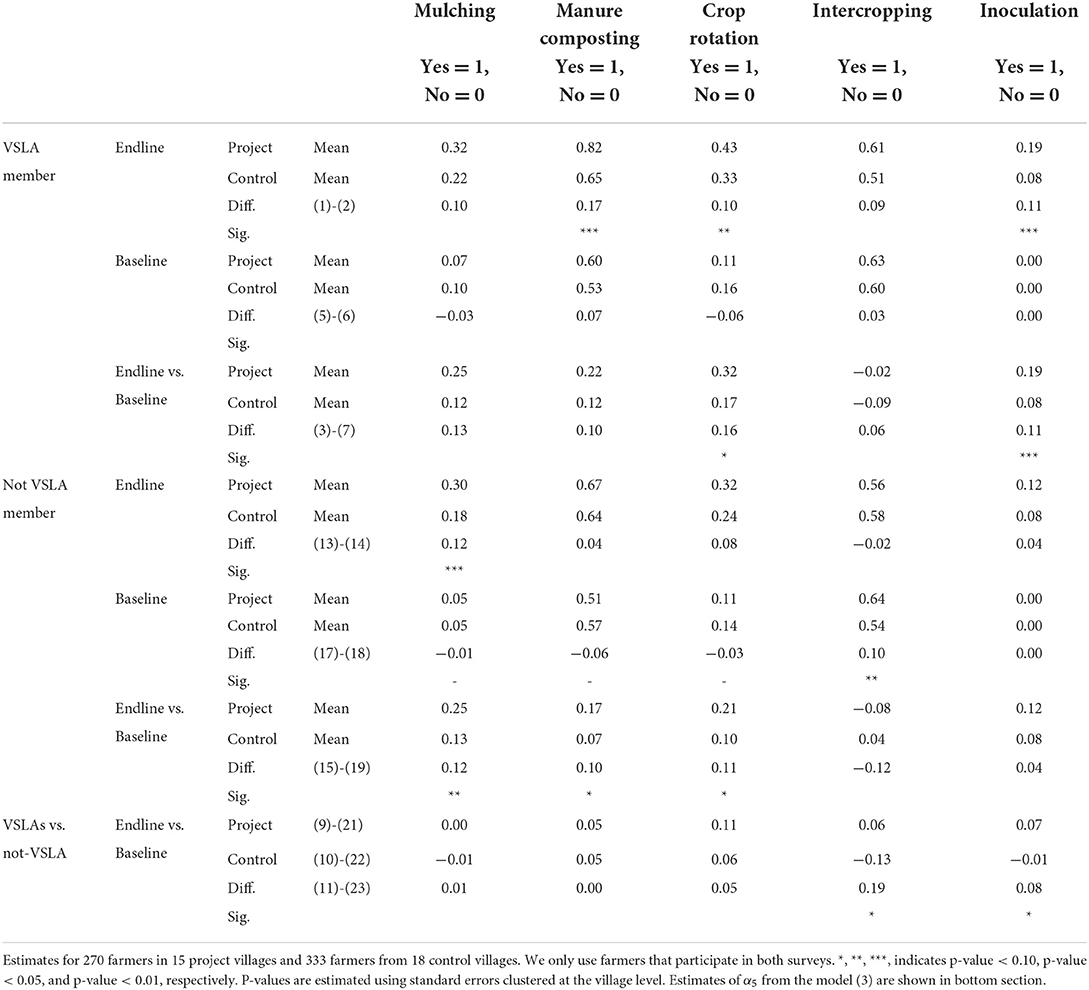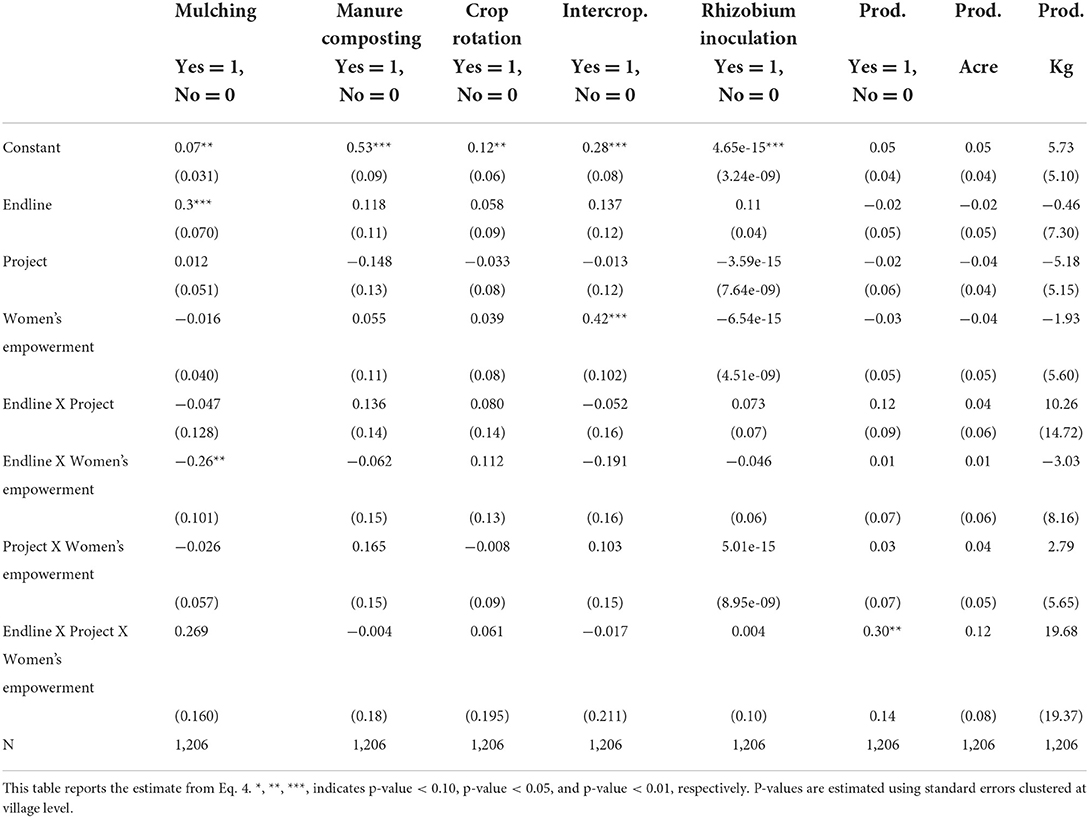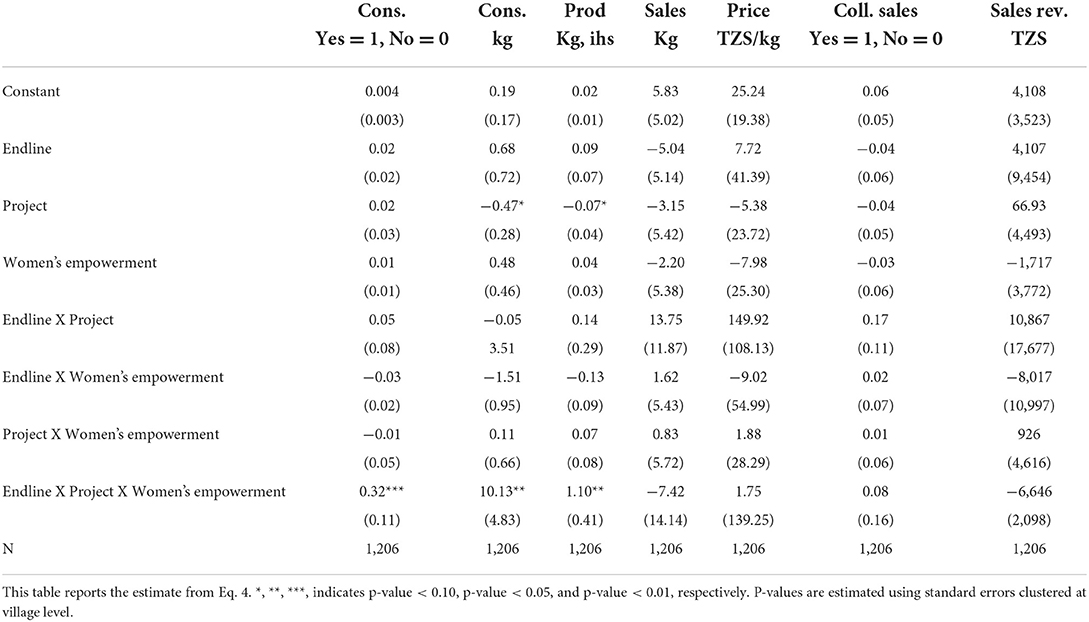- 1Development Economics Group and Wageningen Economic Research, Wageningen University and Research, Wageningen, Netherlands
- 2Wageningen Economic Research, Wageningen University and Research, Wageningen, Netherlands
- 3Alliance of Bioversity International and CIAT Africa Hub Kasarani, Nairobi, Kenya
- 4Department of Trade and Investment, Sokoine University of Agriculture in Tanzania, Sokoine University of Agriculture, Morogoro, Tanzania
We assess the impact of community-based approaches to promote adoption of integrated climate smart agriculture (CSA) practices based on soybean cultivation combined with mulching, intercropping, crop rotation, manure application and rhizobium inoculation methods. We use quasi-experimental data of farmers participating in Farmer Field Business Schools (FFBS) and Village Savings and Loan Associations (VSLAs) in Iringa region of Tanzania. Farmers received technical training and financial support for the initial adoption of soybean production, and women's empowerment supported household's continuous involvement in CSA practices. We find a positive effect for farmers participating in the trainings provided by the FFBSs and receiving microfinance services from VLSA members on the adoption rates of several CSA practices, and this effect became more pronounced for households with higher scores on women empowerment. Farm-level improvement in soybean production and market-level incentives for soybean sales should also strengthen household income, consumption and nutrition levels to maintain CSA practices. Community-based platforms create critical external conditions for introducing CSA practices, but women's empowerment is indispensable for intrinsic incentives for anchoring their adoption.
Introduction
Changes in temperatures and rainfall lead to risks of drought as well as erratic and excess rainfall (Ericksen et al., 2011; WMO, 2020). Many farmers experience climate change as a threat since crop yields to sustain rural livelihoods are seriously challenged (IPCC, 2014; WMO, 2020). Therefore, efforts are made to involve farmers and villages in the adoption of climate-smart agricultural practices that improve resilience of farm production and guarantee household consumption (FAO, 2014). Community participation and stakeholder involvement are frequently used as instruments to effectively stimulate the adoption of climate-smart agricultural (CSA) practices among small-scale farmers in developing countries. But maintenance and long-term anchoring of these CSA practices requires more fundamental shifts in rural decision-making procedures, particularly reinforcing women empowerment (The United Republic of Tanzania, 2014).
Climate-smart agriculture is widely promoted to support rural development, for resource conservation and to ensure food security in a setting of climate change (FAO, 2013; CIAT and World Bank, 2017). CSA thus aims to improve farmers's resilience to climate change, reduce GHG emissions and enhance farmers' agricultural productivity. Most CSA strategies provide technical support and financial services for building capacity to enable the transformation of a range of farming practices, such as drought-resilient seeds, improved soil management (Birol et al., 2010), water conservation, agroforestry, and crop diversification (FAO, 2013; CCAFS, 2021).
Most research on the adoption of CSA practices focusses on the technological potential and the possibilities for adjusting farming systems (Kurgat et al., 2020). Access to knowledge and available and affordable inputs (especially seed) is generally acknowledged as a major enabler for adoption (Jellason et al., 2021). Therefore, programs promoting CSA adoption give most attention to providing suitable external incentives for overcoming such resource constraints. On the other hand, several studies increasingly register farmer's resistance against adoption and growing rates of dis-adoption (Chinseu et al., 2019; Bonilla-Findji et al., 2021). This may be related to limited attention given to risk considerations and neglect of social and community networks as drivers for adoption (Maertens and Barrett, 2013). Moreover, scarce female involvement in farming decisions, limitations to female entrepreneurship and lack of women's control on household resource allocation and food security are considered as major constraints to the sustainable adoption of CSA practices (Wheeler and von Braun, 2013; Bryan et al., 2021).
In line with these arguments, the debate on CSA adoption is gradually shifting from physical and economic farm-level considerations to social and behavioral conditions for household-level anchoring and community-level scaling (Croppenstedt et al., 2003; Daigneault et al., 2016). Anchoring refers to linking processes of technology change with stakeholder intrinsic motivations (Seifu et al., 2020). Anchoring and scaling CSA practices amongst small-scale farm households ask for better understanding of innovation pathways (Duflo et al., 2011; Westermann et al., 2015). Farmers face several barriers to adoption, ranging from limited knowledge (Juana et al., 2013) and innovation skills (Klerkx et al., 2013), constrained access to finance to invest in inputs necessary for the implementation of the practices (Sadler et al., 2016; Ruben et al., 2019) to several types of behavioral barriers (e.g., risk perceptions and attitudes, harmful social and gender norms) (Nigussie, 2017; Jellason et al., 2021). Other problems related to agro-ecological diversity (Andrieu and Kebede, 2020), limited bargaining power on rural markets (Sloan et al., 2019) and low trust in rural institutions (Agrawal, 2008) ask for community-based approaches to simultaneously address household- and village-level distributional conditions for continuous engagement in CSA practice adoption (Scrivens and Smith, 2013).
This article analyzes how community-based approaches that rely on farmer training and access to microfinance provide extrinsic incentives that contribute to the initial adoption of CSA production practices of small-scale farmers in developing countries, whereas additional changes in intrinsic relationships are required to guarantee further scaling and anchoring. We therefore assess the impact of two community-based organizations (CBO's)—namely Farmer Field and Business Schools (FFBS) and Village Savings and Loan Associations (VSLAs)—designed to remove barriers to knowledge and finance for small-scale farmers in developing countries. In addition, we look at the role of gender equity and women empowerment for reinforcing livelihoods as a condition for long-term engagement in CSA practices.
Farmer Field and Business Schools (FFBS) is a participatory extension approach that helps farmers build necessary skills to improve production, access markets and price bargaining, and enhance engagement in common decision-making for joint input purchase and crop sales. Evaluations testing the effects of farmer fields schools show that these can indeed increase the adoption rate of good agricultural practices, thus contributing to higher crop yields, better income of farmers and reduced environmental degradation [see Waddington et al. (2014) for a comprehensive review].
Village Savings and Loan Associations (VSLA) are self-managed group of 20-30 people—mostly women—who meet regularly to provide its members with a safe place to save their money, access loans, and obtain emergency insurance, and a platform for building social capital for collective advocacy (CARE, 2017). Evidence on VSLA impact from randomized control trials is mixed: VSLAs can empower women and help them to improve their entrepreneurship, but household income, food security and assets rarely improved (Karlan et al., 2017). Yet other evidence reveals that VSLA can improve household nutrition and food expenditure through increased agricultural investment financed from a mix of internal savings and external loans (Ksoll et al., 2016).
Both FFBS and VSLA implicitly aim to change household- and community-level gender relations in order to enable women's engagement in productive activities, but also support their decision-making power in intra-household decision-making on expenditures for nutritition and schooling, and reinforce women leadership in community investments in social and collective services (CARE, 2017).
We specifically test different impact pathway of FFBS training and/or VLSA microfinance for promoting the adoption of CSA practices by small-scale farmers, and the role of women empowerment for anchoring these practices. For this purpose, we use a case study from the Iringa Region in Tanzania, a region that is highly vulnerable to weather variability and climate change (CIAT and CARE Tanzania, 2019). In this region, CARE-Tanzania has implemented a four-year project to enhance farmer's adoption of CSA practices, specifically soybean cultivation combined with mulching, intercropping, crop rotation, manure application and rhizobium inoculation methods. In addition, group training and microfinance associations contributed to the transformation of gender norms, both through separate women-oriented events as well as through training provided to couples (Burlando and Canidio, 2017). These activities are meant to improve the effectiveness of FFBS and the functioning of VSLAs, but also contribute to expand the horizon of the project from farming activities to household livelihoods.
This study is based on baseline and endline data gathered from small-scale farm households in project (treatment) and control villages. It uses a quasi-experimental impact evaluation with a difference-in-difference design to assess the impact pathway on four dimensions:
1) comparing farm households' access to agricultural and business training and microfinance credit and savings services in project villages with control villages;
2) examining whether the adoption rate of CSA farming practices increases more in project villages than in control villages between the baseline and endline period;
3) analyzing whether the effects of CSA adoption on soybean production and sales is more pronounced for farmers in a project village that are members of VSLAs and/or received FFBS training;
4) assessing how differences in women's empowerment influence CSA adoption rates and what are the implications thereof for household consumption and nutrition in project villages.
The remainder of the article is structured as follows. Section 2 outlines the theory of change underlying the community-based interventions. Section 3 describes the project region, the field data and the outcome indicators (FFBS training and VSLA microfinance, gender empowerment, CSA adoption). Section 4 presents the results of the different impact pathways. The paper ends with conclusions and policy implications in Section 5.
Theory of change
The theory of change underlying the analysis of differences in adoption of CSA practices between farmers in intervention and control villages considers two different types of community-based promotion activities (namely Farmers Field and Business Schools and Village Savings and Loans Associations) as key inputs, and the uptake of climate-smart agricultural proictices (soybean cultivation and accompanying soil and crop managing practices) as intermediate outcomes. Women empowerment represents a separate dimension (partly supported by women's engagement in FFBS and VSLA activities) that is responsible for translating farm-level outcomes to household-level impact in such a way that it enhances prospects for anchoring of CSA practices. The final welfare impact is measured at two different levels: changes in farm-level production and sales and improvements in household level consumption and nutrition.
CSA adoption and anchoring
The theory of change of the CBO approach in summarized in Figure 1. We identify three separate (albeit related) impact pathways in the CARE Iringa CSA promotion program. First the training impact pathway expects that FFBS activities can improve agricultural and business knowledge amongst participating farmers. The second pathway is the microfinance channel, where farmers can leverage their Village Savings and Loan Association (VSLA) in Figure 1 to solve their financial bottlenecks through saving and loans for different types of farm and household investments. The third pathway refers to women's empowerment: women who increase their control over household revenues (income) or assets (resources) and participate in agricultural production decisions and take leadership positions by involvement in community organizations are more likely to reap positive welfare benefits from the adoption of CSA practices introduced by the project. This is considered as a key condition for the anchoring of CSA practice adoption.
This article tests this theory of change for multiple incentives toward the adoption of CSA practices. In addition to registering the adoption rates of CSA practices (as intermediate outcome), it focuses attention on the expected final impact of using improved CSA practices for increasing soybean production and sales and for improving the income and nutrition level of the households (Conley and Udry, 2010). We particularly assess whether—beyond the knowledge and financial incentives provided through respectively FFBS and VSLAs—also behavioral change through women empowerment is required to guarantee the anchoring of CSA practice adoption. Women empowerment contributes to linking the farm-level production results to household-level consumption and nutrition outcome. Since soybean has high nutritional value as a cheap source of protein with a higher protein content than other legumes, increasing its consumption is considered particularly beneficial to poorer rural households with low average animal protein consumption (El-Agroudy et al., 2011; Foyer et al., 2019; Asodina et al., 2020).
This theory of change builds on different drivers for adoption and anchoring of CSA practices. Whereas extrinsic incentives (such as the provision of training or microfinance services) are useful to support initial adoption of new practices, more intrinsic stimuli are required to tailor the behavior of stakeholders toward more permnanent anchoring of these practices in rural livelihood strategies (Dittrich et al., 2016). While the former incentives may result in improved farm-level outcomes (such as more production or higher sales), the latter changes in behavior are critical to guarantee wider welfare effects at the level of household consumption and nutrition. This integrated farm-household approach to technological change values equity considerations since welfare effects do not remain concentrated by men while major efforts for generating them are made by women (Theis et al., 2018).
Community-based organization
Farmer field business schools
FFBS are participatory group events for introducing new farming practices to small-scale farmers (CARE, 2013). They offer opportunities for knowledge exchange to build the necessary skills to increase production and/or improve access to markets, and sometimes include activities toward collective action (such as joint sales or price bargaining). Women play a key role in the approach, since many agricultural activities and rural transactions are dominated by women.
Farmers in the project villages were offered two integrated FFBS training modules organized in 2018. First, CSA training was facilitated by establishing on-site demonstration plots in every village by CARE-Tanzania in collaboration with local extension officers. Para-professionals lead-farmers that assist the extensions agents from the Ministry of Agriculture identified plots with CSA practices that could be used for daily demonstration. Different varieties of soybean and their combination with manure-composting and rhizobium inoculation were tested in the demonstration plots. Demonstration plots are also used to teach farmers how to use mulching method, the benefits of intercropping, and the role of crop rotation of soybean with other crops. Second, business trainings were organized focussing on collective marketing, business planning, the importance of loans, and how to use them. This training was given in a class format to all members of FFBSs. Although all the trainings were given to the FFBS members, they were also open to other farmers who liked to join. Therefore, a high spill-over effect of the training is expected in the project villages.
Village savings and loans associations
The implementation of the FFBS approach was combined with microfinance services through existing VSLAs in the study area. The VSLAs are self-funded and self-managed groups. They typically comprise 15–25 individual members in a community or village and usually meet weekly or biweekly. VSLA members self-select to save and to lend to each other employing a common fund. The fund, including interests collected, is re-distributed to the members according to the amount of their savings. While groups can include both men and women, usually most of the members are women. They operate independently, only with some additional technical support during the first year.
Village Community Banks (VICOBAs) have been established in the study area in the past. These VICOBAs were like VSLAs because they were member-based, but their field practices differed (Maliti, 2017; Pamuk et al., 2020). For instance, some VICOBAs had about 60 members, which is far more than a typical VSLA (Pamuk et al., 2020), attendance at meetings was low, and not all VICOBAs kept the records of the financial transactions. In several VICOBAs loan enforcement mechanisms were not based on group enforcement and shared liability, andunrepaid loans were funded from the common pool of savings (Maliti, 2017; Pamuk et al., 2020). CARE transformed these existing VICOBAs into VSLAs, offering a refreshing microfinance training focused on record-keeping and joint responsability To ease the record keeping, the project also provided members with a smartphone-based application.
Gender empowerment
The CARE programme organized gender trainings where both men and female spouses involved in the project were expected to participate (CARE, 2020). The objective of the training was twofold. First, it aimed to demonstrate how gender discrimination could leave female farmers behind, negatively affecting the overall welfare of the households and community. In the FFBS training process, couples role-played scenarios on land management and input access, nutritional decision making, workload sharing, and income control, highlighting the traditional role model of men and demostratging the gaps between the existing situation and the ideal case. As a next step, they discussed in groups their daily activities and unequal workload sharing between men and women the differences between male and female behavior, power relationships within the household, the contribution of women to household income and how men and women can share decision making equally.
The members of the FFBS also received training on nutrition. This training included general information on nutrition, food groups, and how a healthy and diverse diet looks like including the demonstration of a healthy plate. It was followed by cooking demonstrations, with demonstrations on how they can cook soybean for their family and the nutritional benefits of soybean consumption. Every month nutrition champions do the cooking demonstration whereby they cook nutritious porridge with soybean to all babies and their mothers who attended the events.
Climate-smart agriculture practices
The KnK project focused on CSA practices of soybean cultivation, combined with mulching, crop rotation and intercropping, using inorganic fertilizer (composting) and rhizobium inoculation applications in 15 villages in Iringa District Council since 2018. Introducing a legume such as soybean in the crop rotation increases soil fertility through nitrogen-fixing. Regular crop rotation can also reduce pathogen pressure on the area. Intercropping is also expected to reduce disease pressure compared with continuous monocropping. Furthermore, total production per hectare is expected to increase, even while each crop yields could decrease due to crop competition. In addition, the nitrogen-fixing characteristic of soybean contribute to the reduction of nitrogen emitted to the atmosphere, reducing GHG emissions from farming.
Soybean farming is relatively new to the region and has only recently emerged as part of the major agricultural value chains (Osiemo and Kweka, 2019) but is expected to enhance the incomes of the farmers. Ng'ang'a et al. (2020) show that both crop rotation or intercropping of soybean with maize is profitable in the project villages. Moreover, returns from crop rotation are substantially higher due to the lower labor input requirements. Their study finds that the net present value of crop rotation of soybean with maize could earn farmers about 4,000 US$ per hectare within 2 years.
The intervention also comprised training farmers in CSA practices as part of the FFBSs programme and supporting access to drought-resilient soybean seed and inoculants from the input retailers. The project itself did not provide any subsidized inputs and investments were fully self-financed by participating farmers, sometimes with assistance of VSLA loans (The United Republic of Tanzania, 2016).
Performance outcomes
The welfare effects of the before-outlined community organization practices for the adoption and subsequent anchoring of CSA practices become visible at different levels. We distinguish between farm-level outcomes that basically focus on improvements in land use, productivity (yield) and production for particular crops. In addition, higher production may increase opportunities for market sales and thus creates additional revenues. Another level where welfare results are assessed refers to the household. This includes changes in labor use (between farm and off-farm employment, or between different cropping and livestock activities) and improvement in intra-household consumption and nutrition standards that in the long run are critical for sustainaing rural livelihoods.
The explicit inclusion of the gender dimention—focussing on women's empowerment as a result of the engagement of women in FFBS and VSLA activities—guarantees that due attention is given to the participation and the bargaining position of women for establishing key internal conditions for maintaining CSA practices in place (even when the external incentives would eventually disappear).
Materials and methods
Field location
We collected household-level data in two survey waves (baseline and endline) from 15 project villages and 18 control villages in Iringa region, Tanzania. Iringa region is one of the major food-producing areas in Tanzania. The agricultural sector employs about 73% of economically active people and generates nearly 99% of GDP. The area enjoys a climate that favors the production of various crops, but production is highly vulnerable to climate variability (Arndt et al., 2012; CIAT and World Bank, 2017).
The region's semi-arid climate has shown significant changes in the past 40 years. Average temperature increased by more than 0.5°C, and annual average precipitation has become erratic (Osiemo and Kweka, 2019). The average income level is low, with annual GDP per capita amounting to 723 US$ or about 2 US$ per capita per day (Iringa Rural District Council, 2013). Most small-scale farmers are vulnerable to rainfall variability, lack knowledge on CSA practices and have limited access to finance. Female farmers are among the most disadvantaged in their access to resources, knowledge and finance (Osiemo and Kweka, 2019).
Farmers in Iringa district are therefore looking for alternative opportunities for stabilizing their rural livelihoods. Change in rainfall pattern, temperature variability and the occurrence of pests and diseases have significant impact on the prospects for rainfed farming. Smallholder in Inringa rely on different adaptation strategies to respond to climate change, ranging from changing the cropping pattern (intercropping, crop rotation) and adjustment in input applications to new soil and crop management practices. This can be achieved by helping smallholder farmers use their local knowledge in combination with introduced innovations to enhance adaptation to the impact of climate change (Kihupi et al., 2015).
The study took place within the framework of the Kukua ni Kujifunza (KnK meaning “Growing is Learning” in Swahili) programme by CARE-Tanzania, implemented at Iringa District, Tanzania. All the villages of the KnK project are in the midlands, a zone of scattered mountain hills and plateau ranging from 1,400 to 2,200 m of altitude. This cool/subhumid agroecological zone is characterized by low temperatures (15–20°C) and high rainfall levels (600–1,000 mm) when compared to the semi-arid plains of the lowlands (Ng'ang'a et al., 2020). The colder rainy season from November to April is the primary growing season, while the dry season lasts from May to October (Ng'ang'a et al., 2020).
Sampling approach
A baseline study was conducted in October-November 2018 using a farming household survey with questions about farming practices in the 2017–2018 farming season. We surveyed 640 small-scale farming households from the 33 project and control villages. In every village, farmers were randomly selected with the help of lists from village leaders and extension officers. In each project villages, 20 farmers were randomly selected as targeted by the project1. In each farming household, the household head (either male or female) or a family member taking part in agronomic decision-making was surveyed. The same respondent answered all questions, including those concerning women's empowerment and the role of women in the households. The data collection was complemented with in-depth interview with key stakeholders on the drivers for CSA adoption (Christopoulos, 2009).
The endline survey was completed in November 2020, comprising almost identical questions that targeted the same household members as those included in the baseline survey, asking about the 2019–2020 farming season. Among 640 households that participated in the baseline, 603 participated in the endline survey. This includes 270 FFBS members from the project villages and 333 control village farmers who participated in both baseline and endline surveys. Thirty seven farmers could not be located for the endline survey, equally distributed between project and control villages.
Figure 2 shows the location of the project and control villages within the Iringa district. The control villages were selected with the help of the Ministry of Agriculture's local government based on their agroecological similarity with the project villages and a minimal level of intervention from external organizations.
Descriptives
We present the baseline characteristics of those 603 farmers from control and project villages in Table 1. On average, farms are small-scale with about 3 acres of farmland. They spend about 23.000 Tanzanian Shillings (TZS), equivalent to about 10 US$ on consumption goods over the past month. Chicken breeding is the major livestock activity and few farmers have cow ownership. Few farmers can access credit from banks or microfinance institutions. Project and control village farmers statistically differ in terms of the gender of the household head, farm size, distance to the main road, and access to finance from microcredit institutions. We control for these characteristics in our detailed regression analysis through fixed-effects regressions, to guarantee that results are robust. STATA and Eview software has been used for data analysis.
This farm-household profile is broadly in line with average family farms in the sub-humid agro-ecological zone of Tanzania. While originally most agricultural production was devoted to semi-extensive arable cropping, with increasing population density and better infrastructure facilities the expansion of commercial crop production gained ground. This is further reinforced by erratic rainfall conditions that favor livestock production and search for integrated farming based on soy cultivation for local and commercial chicken breeding.
Iringa district is thus subject to gradual transformation that is accompanied by different services from the public sector (infrastructure, communication), the private sector (seed provision and marketing) and civic agents (farmer training, microfinance). The effectiveness and impact of the promotion of CSA practices depends on the effective interplay between these stakeholders and their effects on farm household behavior.
Performance indicators
Both baseline and endline household surveys included, among others, performance indicators on the adoption of CSA practices, participation in FFBS training and VSLA, as well as on changes in women's empowerment.
CSA practices
From the full list of potential CSA practices, we focus on practices that are supported by FFBS, namely: crop rotation, intercropping, manure composting, mulching, and soybean cultivation. We used a binary adoption indicators that equals 1 when the practice is used (0 otherwise). For the adoption of soybean, we use more detailed procedures, both binary indicators for adoption and numerical indicator for the amount of acres used and the volume (kg) of soybean produced. To examine the contribution of soybean production to the household income and consumption, we report quantitative indicators (kg/ha and price/kg) and monetary results (amount of Tanzanian Shillings (TZS). Since our data also include farmers that do not produce, consume, or sell soybean, the distribution of those variables is skewed. Since for those series t-test statistics might not produce correct results as they are not normally distributed, we also calculated the inverse hyperbolic sine (ihs) transformation of those skewed variables as proposed by Bellemare and Wichman (2020) and use those transformed series to test the robustness of our results (calculations are available with the authors on request).
FFBS training
Participating in FFBS training is measured binary as well as the total number of times the farmers participated, in addition to farmers' participation in training sessions on 17 topics (binary), including farming, business practices, and gender training.
VSLA services
VSLA indicators address membership over the past year (binary), use of credit and savings (both binary as well as the amount in TZS) and purpose of credit uptake for farming, non-farming, and consumption (binary). We also conducted the ihs transformation of the VSLA indicators in TZS to find correct test results regarding equality.
Women's empowerment
We rely on the women empowerment framework to assess the role of women in the adoption and anchoring of CSA practices2. The indicators used are proxies for the key domains of the Women's Empowerment in Agriculture Index (WEAI), designed to measure relative control and empowerment between spouses within the farm household. We focus on four proxi indicators that measure how much control female adults have within their households over: production decisions (input use, farming practices and sales), resources (asset ownership3), income (decisions on expenditures from sales), and leadership in the community (group membership). Each indicator scores between 0 and 1, whereby 1 reflects a higher level of gender equity within the household. Women empowerment increases when the primary adult female has sole or joint control over resources or decision-making. Each of the four indicators contributes 25% of the overall empowerment index. Table 2 shows the changes in WEIA over the project period, registering major changes in the community leadership dimension.
Some important drawbacks on the construction of the indicators should be mentioned. First, the same respondent, regardless of whether they were male or female, who answered other survey questions also addressed the questions on women's empowerment. Unfortunately we could only interview one member of each household but not both male and female adults as the original WEAI suggests due to the time limitations in the data collection4. Second, households with single or widowed female household heads are excluded in this analysis concerning women's empowerment. This is because WEAI indicators measure women's empowerment relative to male household members, and in single women's households these indicators are not meaningful. Third, compared to the original WEAI, we do not have information on the indicator comparing the time spent on household tasks (e.g., cooking, cleaning and childcare) by female and male adults. Consequently the four indicators used mainly focus on the ability to decide on farming, credit, and capacity to speak publicly.
Estimation strategy
We analyse how FFBS training or VSLA microfinance services directly influence initial CSA practice adoption. In addition, we examine whether Community-based organizations (CBO) indirectly contributes to women's empowerment for anchoring CSA practices. We therefore use difference-in-difference estimates and compare individual impact pathways of FFBS farmer training, VSLA microfinance savings and loans, and changes in women empowerment.
Difference-in-difference
The effectiveness of the FFBS intervention for the key CSA adoption practices was assessed through a quasi-experimental impact analysis using difference-in-difference estimation. We estimate the participation rate in the training of FFBS, access to VSLAs, women's empowerment in agriculture in baseline and endline periods separately for project and control villages and compare them. Then we compare the changes over time and between the farmers from project villages and control villages. We estimate the following model:
where i denotes the farmer, v represents a village, and t denotes time. Endlinet equals 1 when the model use endline survey data (0 otherwise), and Projectv equals 1 when the farmer is from a village where the CBO approach is introduced (0 otherwise). ϵivt is the random error term. Yivt is the outcome indicator. We use participation in the training of FFBS and access to VSLA as key inputs, the adoption of CSA practices and changes in women empowerment as intermediary outcomes, and changes in production and consumption as final results. β1 in Eq (1) estimates the average difference in the outcome indicators between endline and baseline period; β2 estimates the average difference between FFBS/VSLA and control village in the baseline period. Our key variable of interest is β3 which estimates the intention to treat (ITT) estimates of the project: the average effect of the project on the households that the project initially planned to intervene in through the CBO approach.
Comparing different impact pathway
We investigate the training, microfinance, and women's empowerment impacts pathways for CSA adoption and anchoring, respectively.
FFBS farmer training pathway
We first estimate whether the adoption rate of practices is higher among the farmers that are from project villages and participated in FFBS training when compared to farmers that did not participate in the training but in project villages. We estimate the following model:
where FFBSti equals 1 if a member of a farming household participated in a training of FFBS (0 otherwise). We test α5≠0 to examine the change in the effect of the CBO approach on CSA practices with participation in the training.
VSLA microfinance pathway
Second, we explore whether adopting practices increases when farmers from project villages are also VSLA members. We estimate the mean level of CSA adoption indicators in baseline and endline periods at FFBS and control villages, separately for VSLA members and non-member farmers. Then we compare whether the effect of the CBO approach is different (higher) for VSLA members than non-member farmers. For this purpose, we estimate the following model only for those who had adopted CSA practices:
where VSLAi equals 1 if the farmer is a member of VSLA (0 otherwise). We test α5≠0 to examine the change in the effect of the CBO approach on CSA practices with the membership of VSLA.
Women's empowerment pathway
Finally, we analyze whether higher levels of women's empowerment amplify the effect of the CBO approach for the adoption and subsequent anchoring of CSA practices, using the following model:
where Womenempit is the average score of the four WEIA dimensions. Again we test α5≠0 to examine the change in the effect of the CBO approach on CSA practices with women's empowerment in agriculture. We use standard errors clustered at the village level in all our analyses and estimate all models using OLS estimation. Our results are also robust to controlling for farmer fixed effects.
Results
We first assess the participation of farm households in FFBS training and their access to VSLA savings and loans and then identify to what extent this influenced the adoption of CSA practices by comparing baseline and endline data. In a similar vein, we look at how women empowerment changed over different domains between the baseline and endline situation. Hereafter, we analyse how the adoption of CSA practices influences farm-level production and sales of soybean, while women empowerment further contributes to the anchoring of CSA practices by reinforcing household-level consumption and nutrition.
Participation in farmer training and access to microfinance
Farmers access to field and business traing (supplied by FFBS) and rural microfinance loans and savings (through VSLA) are compared between project (intervention) and control villages in the baseline and endline survey (see Tables 2, 3). Diff-in-diff estimates of β3 of model (1) report the change in access to services between farmers from project and control villages over time between baseline and endline. Farmers in project villages that joined FFBS are better trained in climate-smart farming and business practices than those in control villages. In the 2019-2020 season, about 57% of project farmers participated in FFBS activities, while only 17% of farmers in control villages participated in similar activities (see Table 2). The participation rate of farmers from project villages to the various training ranges from 38% (business planning) to 54% (fertilizer use) in the endline survey. This is significantly higher compared to farmers in control villages, even while no major changes in participation over time were registered because trainings in project villages were already on their way before the baseline survey was implemented. We also looked at whether project farmers' business practices improved compared to control farmers. The fraction of farmers who purchase inputs and sell outputs collectively, keep farming records and have a business plan increased significantly in the project villages compared to control villages.
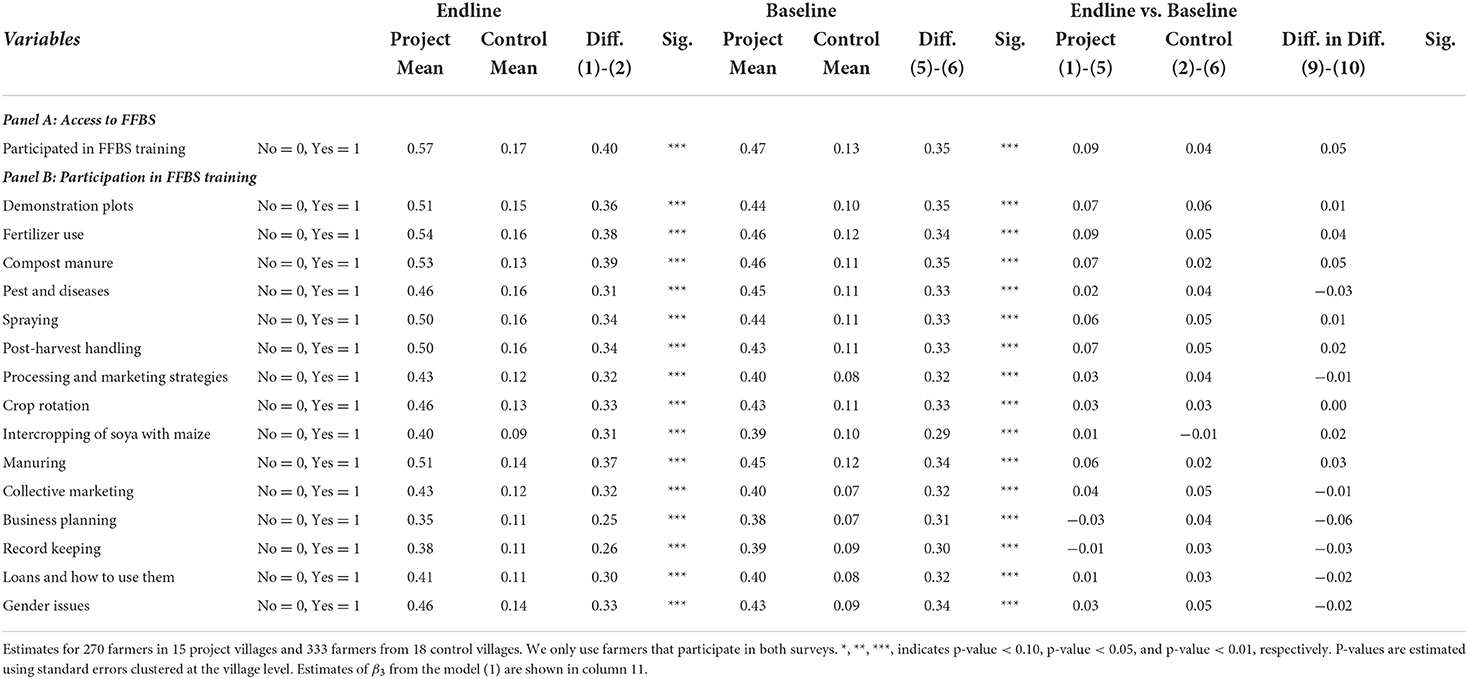
Table 3. Participation in FFBS training in project and control villages (comparing endline and baseline).
Access to finance from VSLAs has improved substantially during the project. In the baseline (2017–2018) there is no statistically significant difference between project and control villages regarding membership in and access to finance from VSLAs (see Table 3). However, in the endline (2019–2020) more farmers from the project villages are members of VSLA villages (50%) than those from control group villages (32%). Those farmers from project villages receive more loans (14%-points, p < 0.10) and attract more savings in the VSLAs than control group farmers in 2019–2020 (20%- points, p < 0.05). Particularly access to loans and savings from VSLAs have improved during the project. The amount in loans granted and saving deposits per farmer more than doubled in project VSLAs compared to farmers in control VSLAs. These are equivalent to over 20,000 TZS (8.6 US$) in additional loans and 30,000 TZS (12.9 US$) in additional savings for project village farmers compared to control village farmers. The results also indicate that the fraction of farmers using loans for non-farm businesses and utilizing the savings for farming and non-farming businesses increased more in the project than control villages. This implies that interventions (e.g., improvements in VSLAs and encouragement of savings for agriculture) have facilitated savings for income diversification activities.
Effect of training and microfinance on adoption of CSA practices
FFBS farm training
The adoption rates of agricultural practices increased with the participation in FFBS training (see Table 4). Estimates of α5 from the model (2) compare the change in the adoption from baseline and endline for project and control villages that participated or not in FFBS activities Results indicate that participation in FFBSs has significantly increased the adoption rates of mulching from baseline to endline. For other practices, we do not detect such an increase in the adoption rates of agricultural practices. But the adoption rate of intercropping decreased significantly among the farmers who did not participate in FFBS activities. This might be because farmers ouside FFBS activities did not sufficiently reap the benefits of intercropping and therefore gave up using this technology.
Farmers that participated in FFBS also adopted more soybean cultivation than farmers that did not participate. In the region, both farmer groups that participated and did not participate in FFBS activities increased the adoption rate of soybean comparing project and control village farmers, but this increase was much more pronounced amongst FFBS farmers where the adoption rate of soybean increased by 48 percentage points more in project villages compared to control villages. Among farmers that did not participate in FFBS, the adoption rate of soybean increased by 15 percentage points. This implies that participation in FFBS activities increased the adoption rate of soybean by about 35 percentage points in project villages compared to control villages (p < 0.01).
VSLA participation
We test whether and how VSLA members from project villages are more likely to adopt agricultural technologies (Table 5). Estimates of α5 from the model (3) are shown. For VSLA members, comparing the project and control farmers, it appears that the project intervention has significantly improved the adoption of manure composting, crop rotation, and the use of rhizobium inoculation during the 2019–2020 cropping season (p < 0.05). The practices' adoption rates were similar in project and control villages in the baseline cropping season. The difference in differences analysis reveals that the project has doubled the adoption of crop rotation (p < 0.10) and inoculation (p < 0.01) technologies. The difference in differences analysis for non-VSLA members reveals that the project also has doubled the adoption of mulching (p < 0.05), manure composting (p < 0.10) and crop rotation technologies (p < 0.10). We find that intercropping and inoculation adoption are high for farmers in project villages and VSLA members. Farmers from project villages who are also members of VSLAs are 19 percentage points more likely to adopt intercropping (p < 0.1) and eight percentage points more likely to adopt inoculation (p < 0.1) when compared to other farmers.
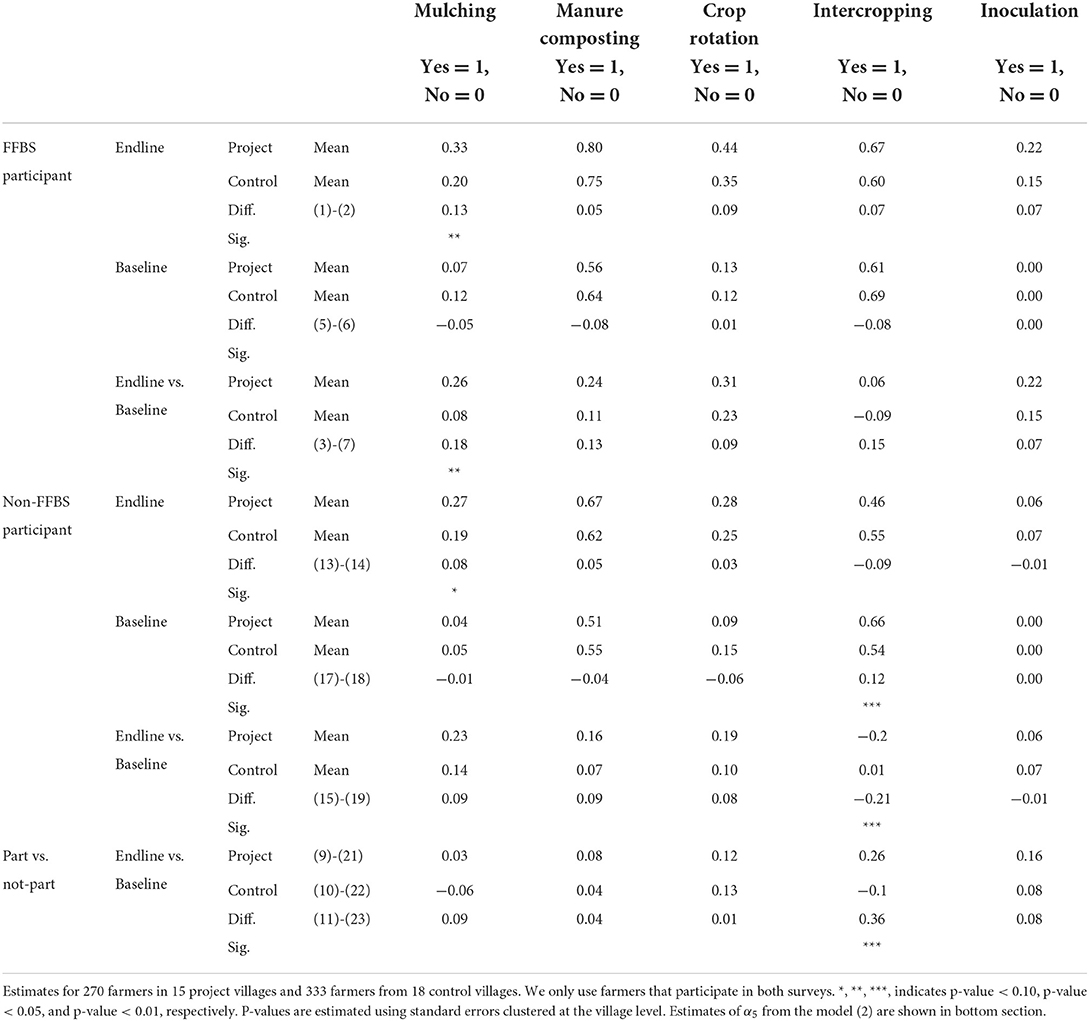
Table 5. Agricultural practices in project and control villages with and without FFBS participation.
Combined FFBS and VSLA package
Finally, we assess the (combined) impact of the FFBS and VSLA package on the adoption of specific CSA practices and soybean cultivation (see Table 6). There was no significant difference between project and control farmers regarding the adoption of agricultural practices in the baseline period, except intercropping. However, from baseline to endline, the fraction of farmers adopting mulching, manure composting, crop rotation, and rhizobium inoculation in project villages is significantly higher when compared to the control villages. In project villages, the adoption rate of mulching, manure composting, crop rotation and inoculation increased between 7 to 14% points. We could not detect a joint effect of CBO on intercropping, even while individual FFBS and VSLA activities register increased adoption. This might be because farmers face difficulties of making intercropping economically viable. This is in line with Ng'ang'a et al. (2020) who show that intercropping of soybean with maize is less profitable than crop rotation due to additional labor costs. Also, in our interviews, the lead farmers from the project villages pointed out that they find it inefficient to implement intercropping in small plots and prefer crop rotation.
Impact of community-based approach on soybean returns
We also assess the effect of the CBO approach on soybean production, trade and consumption outcomes. When the project started, the fraction of farmers producing soybean was approximately 3% in both project and control villages with an average production ranging from 1 to 4 kg per farm. None of the consumption and sales indicators was statistically different between project and control villages in the baseline.
After two years of encouraging soybean adoption, the fraction of soybean adoption increased to 35% in the project villages compared to the control villages. On average, a project farmer harvested approximately 23 kg of soybean using 0.12 acres of farmland in the 2019–2020 farming season (see Table 7). When we exclude farmers not producing soybean, this amounts to 64 kg per project farmer (0.33 acre of land). In the same season, 32% of project farmers (about 89% of soybean producers) consumed on average 7 kg of soybean (equivalent to about 22 kg of soybean consumption for the farmers who consumed the soybean they had produced). About 12% of project farmers (one-third of the soybean producers) sold on average 6 kg soybeans. In 2019–2020, project farmers report that the average farmgate soybean price was 1,397 TZS (0.60 US$) per kg. As a result, sales of the project farmers increased on average by 4,989 TZS (2.15 US$), and more specifically, soybean selling project farmers by 41,575 TZS (17.94 US$).
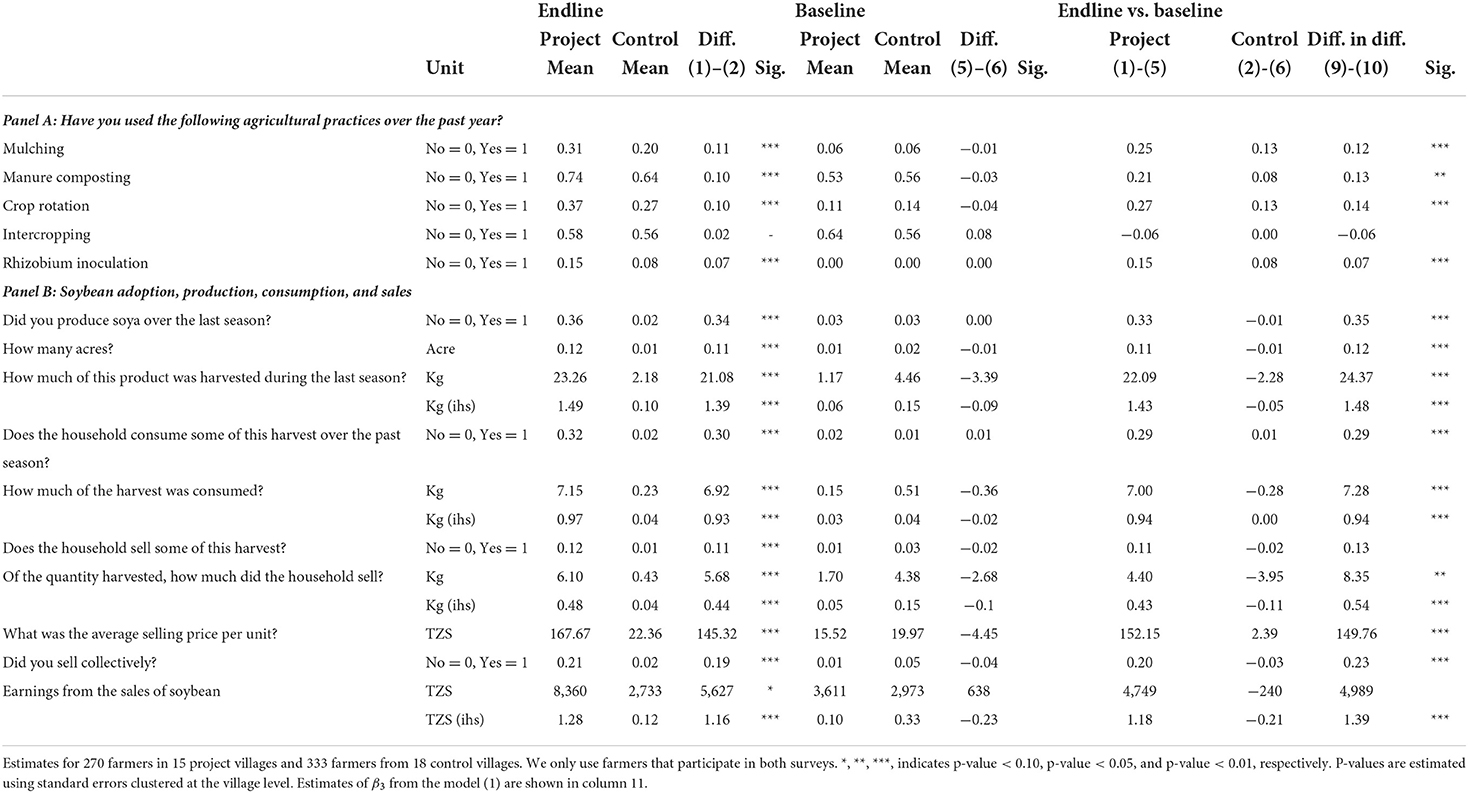
Table 7. Use of agricultural technologies, soybean production and consumption in project and control villages (endline and baseline surveys).
This effect was also reflected in other soybean production, marketing and consumption indicators. Thanks to FFBS activities, the area reserved for soybean production increased by 0.15 acres, resulting in about 35 kg more soybean production and 12 kg more soybean consumption. This implies that participation in FFBS played a key role in the upscaling of soybean production through the village-based approach. The approach also had spill over effects on soybean adoption among the farmers who did not participate in FFBS activities at the project villages.
These results on CSA practices and, more specific on soybean production, show that the CBO approach can improve the adoption of CSA practices, including soybean production and consumption, which contributes to the nutrition level of farmers and improves their income. Using the findings from Ng'ang'a et al. (2020) and correcting for the 0.60 US$ per kg price—(which was found to be 0.75 US$ per kg in their study), we roughly estimate the annual income contribution of soybean production. Our estimates show that the net present value of producing soybean is about 419 US$ in 15 years period when the farming area for soybean and prices do not change5. Soybean consumption is also important for the nutrition level of the farmers. In the baseline survey, in a seven-day period, about 91% of the farmers in project villages ate dry beans at least once a week. About 45% of them ate cow meat, 33% could eat dry fish at least once in the same seven day period. This illustrates that farmers rely on bean-sourced protein instead of animal-sourced protein. Soybean, which has a higher protein content than other beans, helps farmers to close that protein intake gap, providing a cheap and protein rich legume alternative.
This combined consumption and income effect of the CBO approach could be higher if farmers would dedicate more area for soybean farming or involve more farmers. The average farm size in our sample is about 2.85 acres, while soybean producing farmers only use 0.33 acres (about 10% of total farm size). This gives an important opportunity to upscale the adoption of soybean. Moreover, about 64% of farmers who participated in the project villages did not adopt soybean, so there is much room for outscaling. To understand the factors preventing the adoption of soybean production we analyse the barriers reported by the farmers who participated in the project villages in our endline survey. Three major reasons for not adopting were identified: the high cost of production, unsuitable weather conditions, and lack of access to seeds due to limited supply. Respectively about 30, 23, and 21% (74% in total) of non-adopters report those as the reasons for not cultivating soybean
Hereafter, we test whether VSLA members from the project villages are able to reach higher soybean production, consumption, and sales compared to control villages (Table 8, 9). The results show that the project has increased soybean adoption for both VSLA members and non-VSLA members in the 2019–2020 cropping season comparing project to the control farmers (p < 0.01). This holds for the number of farmers producing soybeans, the area under soybean production, and soybean yield per unit area. Consequently, this leads to an increase in the average amount of soybean consumed and sold, and improved soybean sales revenue for both VSLA and non-VSLA members.
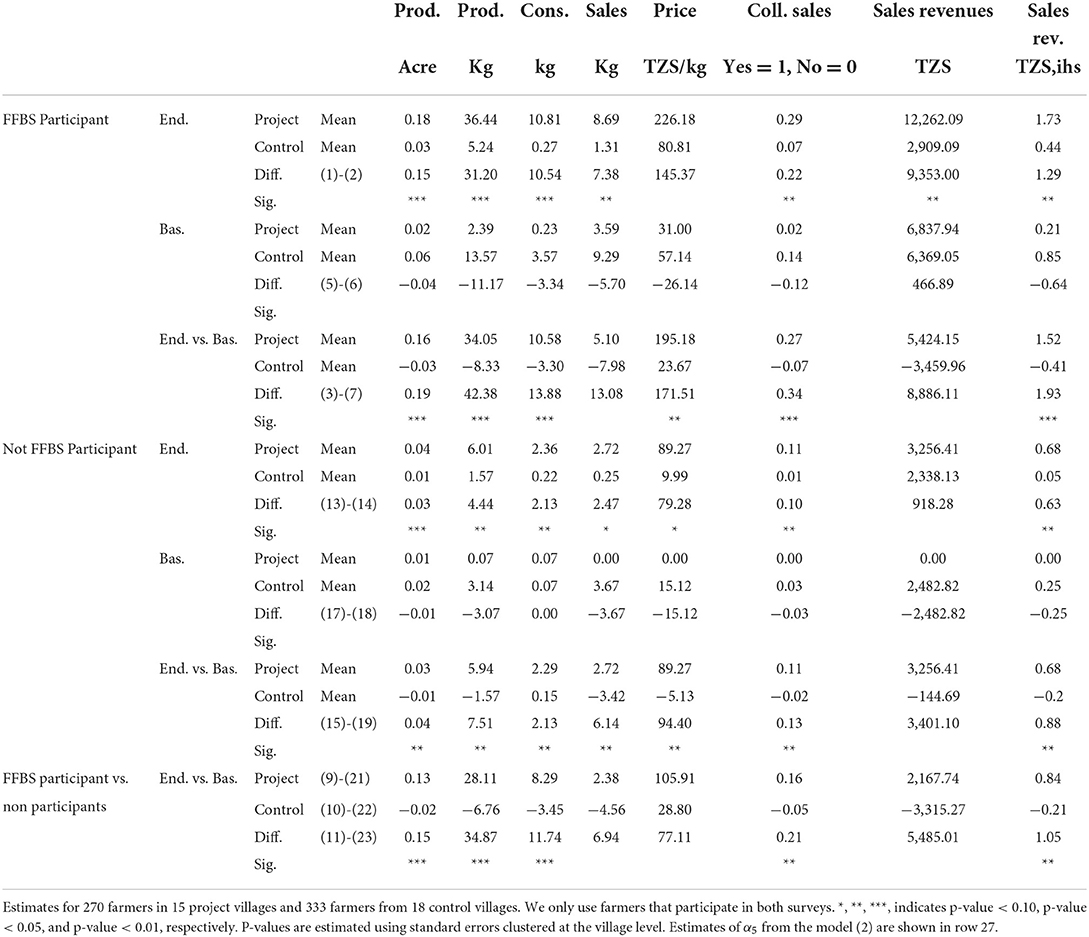
Table 8. Soybean production, consumption and sales in project and control villages by FFBS participation.
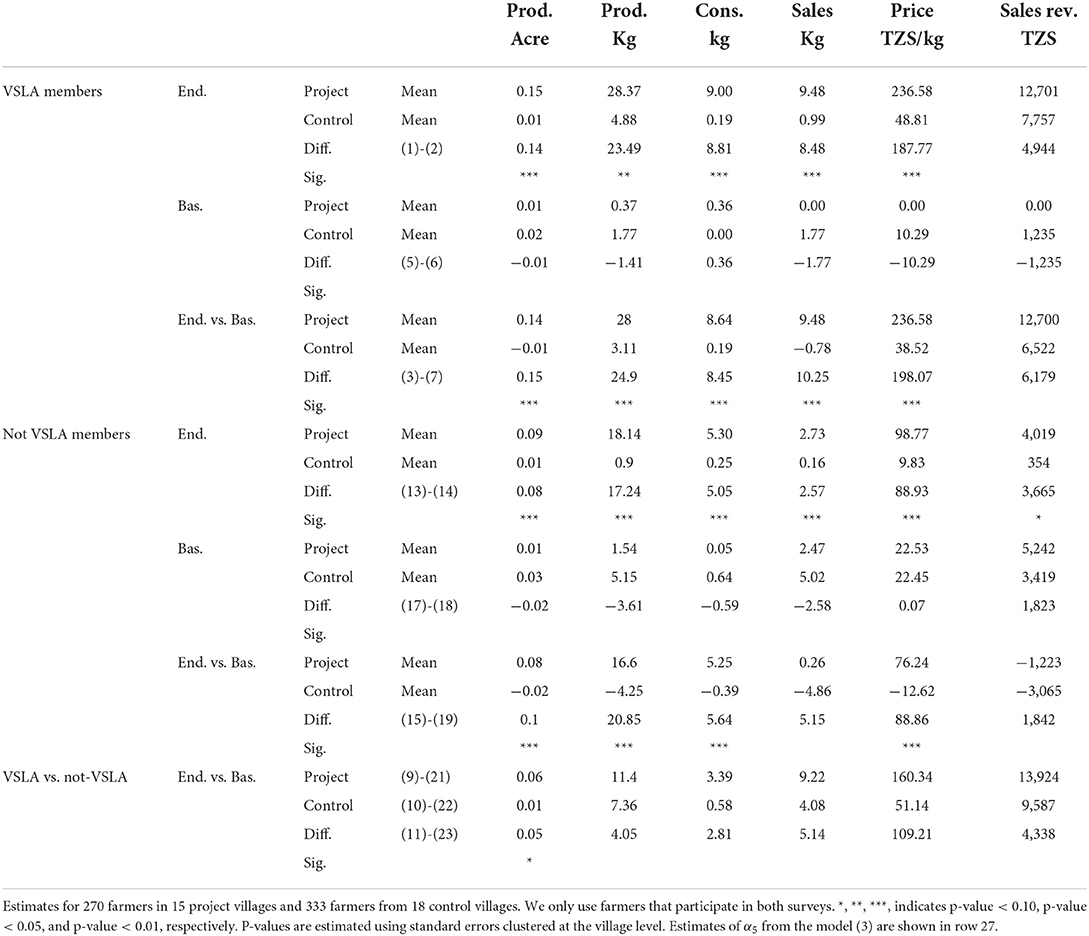
Table 9. Soybean production, consumption and sales in project and control villages by VSLA membership.
In the baseline cropping season, soybean production and consumption were similar for both the VSLA members and non-VSLA members. However, the difference in differences analysis shows that the CBO approach significantly (p < 0.01) increased the adoption of soybeans, as well as the area under production, yield per unit area, consumption and sales, and the sales revenue for both VSLA and non-VSLA members. However, the effect of combined FFBS+VSLA is more pronounced for VSLA members. Farmers from project villages who are members of a VSLA are more likely to adopt soybean production (17%-points, p < 0.05) than farmers from project villages but not members of VSLAs. As a result, project village farmers who are also members of VSLAs (at p < 0.1) have a higher increase in the area under soybean production, the amount of soybean consumed and sold, the price per unit of soybean and the sale revenues when compared to farmers who are from project village but not members of VSLA.
We also looked at whether the influence of VSLA membership results in more use of saving or higher reliance on farming loans. Households from project villages that used VSLA loans for farming are more likely to adopt CSA practices than those from project villages but not using the VSLA loans. On the other hand, there is no statistically significant difference between the CSA adoption rates by households from project villages that use and do not use savings in VSLAs to finance farming activities. This may imply that targeted loans are more important for CSA adoption that accumulated savings; the latter are likely to be more consumption-oriented. Overall, these results imply that the VSLA impact pathway of the combining FFBS+VSLA are fully complementary. The effect of the CBO approach is higher for the farmers who are a member of a VSLA and use loans to finance farm investments.
Role of women's empowerment
The community-level approach improved the leadership role of women (p < 0.01) measured by their involvement of socio-economic groups in the village, corresponding to a 0.16 (55% when compared to baseline control village average) increase in the leadership score (see Table 2). However, we could not detect a statistically significant effect on women's control over income, resources, and production. The improvement in women's leadership is reflected in a higher overall women's empowerment index in project villages than in control villages.
Interestingly enough, neither FFBS nor VSLA participation on their own deliver significant changes in women empowerment, but the combination of FFBS platform that improve the role of women in farming production decisions and their leadership in joint marketing networks with VSLA facilities that provide access to resources and reduce risks for women contribute substantially to the higher household impact of CSA adoption and anchoring.
We also examine how the effect of CBO approach on the farm-level adoption of CSA practices changes by the level of women's empowerment at household level. Our results provide conclusive evidence that women's empowerment reinforces the outcomes of community-based approaches for training and microfinance (see Table 10). We find that farm households in project villages are able to reach higher soybean production and consumption outcomes when the women in the households are more empowered.
These results on women's empowerment align with the theory of change of the CBO approach. A seven percentage point increase in the women's empowerment score—equivalent to the joint effect of the CBO approach—enhances the results of community-based activities on the likelihood of producing soybean by 2.1 percentage points. This implies that women can more easily access resources and information on new agricultural practices in households with a higher women's empowerment score. They also have more influence on farm-level decisions to produce more soybean.
Mot importantly, the increased soybean production facilitated by women's empowerment is also translated into increased soybean consumption. A 7 percentage point increase in the empowerment score enhances the CBO approach effect on soybean consumption by 0.7 kg per household (Table 11). This implies that women's empowerment also increases the effect of the CBO approach on the nutritional wellbeing of households. Women use their knowledge on nutritional benefits of soybean intake for simultaneously improving farm-level soybean production and household-level nutrition and diets.
The latter effect is considered particularly important for anchoring the use of CSA practices and to support further outreach and scaling of soybean cultivation. Progress in women's empowerment provides the necessary intrinsic drivers for continuating farm-household engagement in soybean cultivation with integrated CSA methods.
Discussion and conclusion
In this article we analyzed the impact of community-based organization for the adoption of CSA practices, considering simultaneous changes in women empowerment that create prospects for CSA anchoring. This analysis is embedded in the discussion on the economic, social and behavioral incentives required to tackle common barriers that hinder adoption (i.e. high risk; lack of control; uncertain revenues, etc.) and the potential role institutional frameworks for collective action, social exchange and women empowerment that may be critical for overcoming these constraints (Klerkx et al., 2013; Maertens and Barrett, 2013; Bonilla-Findji et al., 2021).
While most earlier studies on the prospects for adoption of CSA practices focus attention on resource and information constraints (Juana et al., 2013; Kurgat et al., 2020), our findings offer better insights into the role of community-level instutitutions (VSLA, FFBS) for enhancing smallholder engagement with innovation programs (Ksoll et al., 2016; Karlan et al., 2017), as well as the importance of organized interactions and complementarities between different types of interventions (Chinseu et al., 2019). In addition to material incentives that support initial CSA adoption, for CSA anchoring it turns out to be far more important to induce behavioral changes that enable smallholder households to exchange information, share risks and strengthen women empowerment.
Our study pays particular attention to the practical opportunities for influencing farmers' adoption behavior. We find important evidence in four areas.
First, farmers in project villages took great interest in community-based programs. The participation rates in FFBS training the project villages were substantial, varying between 38 and 54%, depending on the training topic. The training changed several business practices of farmers, particularly farm record keeping and the collective purchase of inputs. The CBO model proved to be an effective platform also for training on farmer business practices. Membership of VSLAs increased from 20–30% to 30–50%. It is plausible that the project had a positive effect on this. The annual savings amounts per VSLA member grew, partly as an effect of the trainings, from an average of 15-19 US$ per member to 27-45 US$. Similarly, the annual loans per VSLA member increased from an average of 14-16 US$ to 24-36 US$. Some of these savings and loans were used for investments in farming or other business activities.
Second, it proved to be possible to enhance the adoption rates of CSA practices during the project. With the project, the adoption rate of CSA practices, including mulching, manure composting, crop rotation and rhizobium inoculation, increased. The FFBS and VSLA interventions had a positive effect on these changes. Commercial cropping of soybean became more important, but intercropping lost traction, possibly because it proved to be more labor-intensive and less economically viable than crop rotation (Ng'ang'a et al., 2017a,b). Also, the adoption of soybeans as a soil-enriching and nutritious crop increased in the project area. Many farmers started cultivating soybeans, from 3% at baseline to 36% at endline in the project villages, and the average acreage grew from garden scale to roughly one-third of an acre. About one-third of the soybean was sold in small quantities on the market, but soybeans consumption at home als increasded. In the long term, we expect that soil-enriching characteristics of soybean will also positively contribute to the overall productivity of other crops (e.g., maize) as farmers use crop-rotation of soybean with other crops.
Third, the CBO approach was successful in training households in farming and business practices. The linkage with VSLAs reinforces the effectiveness of the FFBS. The VSLA members in the project villages show a higher rates of CSA adoption than non-members, specifically in intercropping and rhizobium inoculation. Similarly, they also show higher production and sales of soybean than non-VSLA members. This commercially-oriented impact pathway is more pronounced for farmers that use loans from VSLAs to finance their farming activities.
Fourth, the CBO approach also contributed positively to women's leadership and women's membership in socioeconomic groups. Throughout the project, women's participation in socioeconomic groups increased more in project villages than in control villages, even while no direct effect could be measured on women's control over income, resources, and production. Households with a high degree of women's empowerment—as witnessed by the WEAI score—show better CSA adoption performance. This is the case for the adoption of soybean, generating both production and consumption effects, and can also be understood because women that are empowered in the household have better access to resources and information and decision making capacity on new agricultural practices. Women are powerful in farm household decision making and the training provided by the project on the nutritional benefits of soybean for their family further supported CSA anchoring.
These outcomes suggest that the CBO approach of combining farmer training, microfinance, and women's empowerment can have positive effects on the adopting CSA practices. The set of combined interventions (i.e., credit and savings, training on CSA practices and soybean production) are well tailored toward the opportunities and assets in a small-scale subsistence economy where food and nutrition security and resilience are key priorities. Furthermore, the sales of soybean through collective action might open a new trajectory for farmers to start aggregating their produce for commercial sales.
For policymakers, this implies that it may make sense to replicate this model in a quest to support CSA adoption at scale. In addition to providing knowledge and material support, it proved to be equally important to invest in behavioral change activities that reinforce farmer's willingness to adopt. Efforts for increasing women's empowerment are essential to ensure that benefits from CSA adoption become equally distributed. Moreover, women's participation in production decisions will improve when they participate more in training and microfinance programs. This may also be helpful to guarantee that loans from VSLAs are used more for investments to stimulate CSA practices and are not limited to direct consumptive purposes. The latter improvements in household consumption and nutrition will be the result of earlier CSA investments.
Integrated policies for the adoption and anchoring of CSA practices also should address the likely trade-offs between production, sustainability and equity objectives (Lipper et al., 2014). While material incentives tend to focus on production and income effects, institutional innovations devote more attention to resource exchange and income sharing arrangements. Support to community networks and women empowerment may thus pay-off in terms of higher and more prolonged adoption of CSA practices (Agrawal, 2008). Instead of “pushing” the adoption of single practices, creating the conditions for “pulling in” a set of combined innovations will be more successful for anchoring a comprehensive CSA systems transformation (Murage et al., 2015; Kopper and Ruelle, 2022).
Finally, further research is needed to confirm whether the adoption effects are lasting in the longer run, and whether they can be sustained without additional external resources or repeated trainings or coaching. This would require further research to explore the funding base for the replication of this approach. So far, the FFBS+VSLA intervention in Iringa is still not based on a profitable business model that could make the replication commercially scalable. Therefore, replication requires public resources or civic sponsorships, and remains dependent on external support (The United Republic of Tanzania, 2015).
In the future, engagement from the private sector—such as traders and commercial agribusiness companies—is needed to reinforce the soybean supply chains and enable farmers to make the necessary “green” investments. This meets its payback in terms of better compliance with standards and government regulations for country contributions to the Paris Agreements. It might also be possible to rely on contributions from climate funds that prioritize adaptation and mitigation measures. While public investments and private or civic sponsorships can be useful as (temporary) support for initial CSA adoption, it remains of critical importance to guarantee behavior change through women empowerment and collective action to guaranty the anchoring of CSA practices at scale.
Data availability statement
The raw data supporting the conclusions of this article will be made available by the authors, without undue reservation.
Ethics statement
Ethical review and approval was not required for the study on human participants in accordance with the local legislation and institutional requirements. Written informed consent for participation was not required for this study in accordance with the national legislation and the institutional requirements.
Author contributions
HP contributed to the study design, data analysis, survey instrument design, and reporting. MA and CW contributed the study design, survey instrument design, and reporting. JH managed the data collection and contributed to the survey instrument design, data analysis, and reporting. SN contributed to the survey instrument design, data analysis, and reporting. RR contributed the study design and reporting. All authors contributed to the article and approved the submitted version.
Funding
This study is part of the NWO-CCAFS research project Upscaling CSA with small-scale food producers organized via VSLAs: Financing for adoption, behavioral change, and resilience in rural Iringa Region in Tanzania. The research project benefits from the support of NWO's Food and Business Global Challenges Programme and the CGIAR Research Program on Climate Change, Agriculture and Food Security (CCAFS). It is carried out with support from CGIAR Fund Donors and through bilateral funding agreements. For details, please visit https://ccafs.cgiar.org/donors.
Acknowledgments
We thank Devinia Akinyi for her excellent research assistance during this project, Tumainiely Kweka, Edgar Begasha, Blandina Karoma, and Thabit Masoud from CARE-International in Tanzania, Karl Deering from CARE-USA, Miriam van Muijlwijk and Merlijn van Waas from CARE Nederland for their comments, and contributions to the study.
Conflict of interest
The authors declare that the research was conducted in the absence of any commercial or financial relationships that could be construed as a potential conflict of interest.
Publisher's note
All claims expressed in this article are solely those of the authors and do not necessarily represent those of their affiliated organizations, or those of the publisher, the editors and the reviewers. Any product that may be evaluated in this article, or claim that may be made by its manufacturer, is not guaranteed or endorsed by the publisher.
Footnotes
1. ^We originally also included another 20 farmers in project villages that were not initially targeted, in order to analyze potential spillovers. This sub-sample is not included in the current analysis. When the baseline survey was completed, it appeared that several farmers from project villages already participated in earlier training from FFBS in the second half of 2018. However, as the agricultural season had already started, they did not have the opportunity to implement the practices. Therefore, we expect that farmers in the project villages may have started to participate in the FFBS training before the baseline survey.
2. ^Please also see Fuchs (2021) for a detailed discussion and use of women's empowerment indicators.
3. ^Only assets owned by at least 200 households or at least 30% of the households are considered relevant for coping against shocks. Critical resources are radios, phones, sprayers, kraals, storage facilities and chicken stock.
4. ^Consequemntly, this study could not construct a gender parity index of the WEAI that measures the empowerment gap between the primary adult male and female household members (with a weight of 10% of the original score).
5. ^To estimate the value of soybean adoption we use the estimate from Ng'ang'a et al. (2020) for the net present value cultivation crop-rotation of soybean with early maturing soybeans. This equals to 4028 US$ per hectare net present value over a 15-year period. In that study authors use a soybean price of 0.75 US$ per kg but in our study the price is 0.60 US$ per kg. Moreover, a soybean-producing farmer use 0.13 hectare of land for soybean. Then we estimate 15 years net present value using formula: 4028 US$*(0.60/0.75)*0.13 = 419 US$.
References
Agrawal, A. (2008). The Role of Local Institutions in Adaptation to Climate Change. Working Paper # 69128. Washington, DC: World Bank.
Andrieu, N., and Kebede, Y. (2020). Climate Change and Agroecology and case study of CCAFS. CCAFS Working Paper No. 313. Wageningen: CGIAR Research Program on Climate Change, Agriculture and Food Security.
Arndt, C., Farmer, W., Strzepek, K., and Thurlow, J. (2012). Climate Change, Agriculture, and Food Security in Tanzania. Washington, DC: World Bank. doi: 10.1596/1813-9450-6188
Asodina, F. A., Adams, F., Nimoh, F., Weyori, E. A., Wongnaa, C. A., and Bakang, J. E. A. (2020). Are non-market benefits of soybean production significant? An extended economic analysis of smallholder soybean farming in Upper West region of northern Ghana. Agric. Food Secur. 9, 1–13. doi: 10.1186/s40066-020-00265-7
Bellemare, M. F., and Wichman, C. J. (2020). Elasticities and the inverse hyperbolic size transformation. Oxford Bull. Econ. Stat. 82, 50–61. doi: 10.1111/obes.12325
Birol, E., Koundouri, P., and Kountouris, Y. (2010). Assessing the economic viability of alternative water resources in water-scarce regions: combining economic valuation, cost-benefit analysis, and discounting. Ecol. Econ. 69, 839–847. doi: 10.1016/j.ecolecon.2009.10.008
Bonilla-Findji, O., Eitzinger, A., and Andrieu, N. (2021). Implementation Manual: CCAFS Climate-Smart Monitoring Framework - Tackling Uptake of CSA Options and Perceived Outcomes at Household and Farm Level. Wageningen: CGIAR Research Program on Climate Change, Agriculture and Food Security (CCAFS).
Bryan, E., Kato, E., and Quinn, B. (2021). Gender differences in awareness and adoption of climate-smart agriculture practices in Bangladesh. In gender, climate change and livelihoods: vulnerabilities and adaptations. Eastin, J., and Dupuy, K., editors. Part Three: Addressing the Gendered Impacts of Climate Change on Livelihoods, Chapter 10. Wallingford CABI. p. 123–42.
Burlando, A., and Canidio, A. (2017). Does group inclusion hurt financial inclusion? Evidence from ultra-poor members of Ugandan savings groups. J. Dev. Econ. 128, 24–48. doi: 10.1016/j.jdeveco.2017.05.001
CARE (2013). The Farmer Field and Business School: A Pathways Programming Approach. Atlanta: CARE Innovation Brief.
Chinseu, E. L., Stringer, L. C., and Dougill, A. J. (2019). An empirically derived conceptual framework to assess dis-adoption of conservation agriculture: multiple drivers and institutional deficiencies. J. Sustain. Dev. 12, 48–63. doi: 10.5539/jsd.v12n5p48
Christopoulos, D. (2009). Peer esteem snowballing: a methodology for expert surveys. Proceedings of Eurostat Conf. New Tech. Technol. Stat. 171–179.
CIAT and CARE Tanzania (2019). Tanzania Country Climate Risk Profile Series. Cali: International Center for Tropical Agriculture (CIAT) and CARE Tanzania.
CIAT and World Bank (2017). Climate-Smart Agriculture in Tanzania. CSA Country Profiles for Africa Series. International Center for Tropical Agriculture (CIAT). Washington, DC: World Bank.
Conley, T. G., and Udry, C. R. (2010). Learning about a new technology: pineapple in Ghana. Am. Econ. Rev. 100, 35–69. doi: 10.1257/aer.100.1.35
Croppenstedt, A., Demeke, M., and Meschi, M. M. (2003). Technology adoption in the presence of constraints: the case of fertiliser demand in Ethiopia. Rev. Dev. Econ. 7, 58–70. doi: 10.1111/1467-9361.00175
Daigneault, A., Brown, P., and Gawith, D. (2016). Dredging versus hedging: comparing hard infrastructure to ecosystem-based adaptation to flooding. Ecol. Econ. 122, 25–35. doi: 10.1016/j.ecolecon.2015.11.023
Dittrich, R., Wreford, A., and Moran, D. (2016). A survey of decision-making approaches for climate change adaptation: Are robust methods the way forward? Ecol. Econ. 122, 79–89. doi: 10.1016/j.ecolecon.2015.12.006
Duflo, E., Kremer, M., and Robinson, J. (2011). Nudging farmers to use fertiliser: Theory and experimental evidence from Kenya. Am. Econ. Rev. 101, 2350–2390. doi: 10.1257/aer.101.6.2350
El-Agroudy, N., Mokhtar, S., Zaghlol, E. A., and ElGebaly, M. (2011). An economic study of the production of soybean in Egypt. Agric Biol J N Am. 2, 221–5. doi: 10.5251/abjna.2011.2.2.221.225
Ericksen, P., Thornton, P., Notenbaert, A., Cramer, L., Jones, P., and Herrero, M. (2011). Mapping Hotspots of Climate Change and Food Insecurity in the Global Tropics. CCAFS Report No. 5. Copenhagen: CGIAR Research Program on Climate Change, Agriculture and Food Security (CCAFS).
FAO (2013). Climate Smart Agriculture Sourcebook. Rome: Food and Agriculture Organization of the United Nations.
Foyer, C. H., Siddique, K. H. M., Tai, A. P. K., Anders, S., Fodor, N., Wong, F. -L., et al. (2019). Modelling predicts that soybean is poised to dominate crop production across Africa. Plant Cell Environ. 42, 373–385. doi: 10.1111/pce.13466
Fuchs, M. (2021). Gender Roles and Climate-Smart Agricultural Practices: Evidence From Rural Tanzania. Masters' Thesis. Wageningen: Wageningen University and Research.
IPCC (2014). Climate Change 2014: Synthesis Report. Contribution of Working Groups I, II and III to the Fifth Assessment Report of the Intergovernmental Panel on Climate Change. Geneva: IPCC.
Iringa Rural District Council (2013). Iringa Rural Socio-Economic Profile. Available online at: http://www.iringa.go.tz/storage/app/uploads/public/591/32c/3b5/59132c3b52923799622512.pdf (accessed July 15, 2022).
Jellason, N., Conway, J. S., and Baines, R. (2021). Understanding impacts and barriers to adoption of climate-smart agriculture (CSA) practices in North-Western Nigerian drylands, J. Agric. Educ. Extension, 27, 55–72. doi: 10.1080/1389224X.2020.1793787
Juana, J. S., Kahaka, Z., and Okurut, F. N. (2013). Farmers' perceptions and adaptations to climate change in Sub-Sahara Africa: a synthesis of empirical studies and implications for public policy in African Agriculture. J. Agric. Sci. 5, 121–135. doi: 10.5539/jas.v5n4p121
Karlan, D., Savonitto, B., Thuysbaert, B., and Udry, C. (2017). Impact of savings groups on the lives of the poor. Proc. Nat. Acad. Sci. 114, 3079–3084. doi: 10.1073/pnas.1611520114
Kihupi, M., Chingonikaya, E., and Mahonge, C. (2015). Smallholder farmers' perception of climate change versus meteorological data in semi-arid areas of Iringa District, Tanzania. J. Environ. Earth Sci. 5. 137–147. Available online at: https://www.suaire.sua.ac.tz/handle/123456789/3692
Klerkx, L., Adjei-Nsiah, S., Adu-Acheampong, R., Saïdou, A., Zannou, E., Soumano, L., et al. (2013). Looking at agricultural innovation platforms through an innovation champion lens: an analysis of three cases in West Africa. Outlook on Agric. 42,185–192. doi: 10.5367/oa.2013.0137
Kopper, R. W., and Ruelle, M. L. (2022). Is push-pull climate- and gender-smart for Ethiopia? A review. Agroecol. Sustain. Food Syst. 46, 23–55. doi: 10.1080/21683565.2021.1958972
Ksoll, C., Lilleør, H. B., Lønborg, J. H., and Rasmussen, O. D. (2016). Impact of Village Savings and Loan Associations: Evidence from a cluster randomized trial. J. Dev. Econ. 120, 70–85. doi: 10.1016/j.jdeveco.2015.12.003
Kurgat, B. K., Lamanna C., Kimaro, A., Namoi, N., Manda, L., and Rosenstock, T. S. (2020). Adoption of Climate-Smart Agriculture Technologies in Tanzania. Front. Sustain. Food Syst. 4:55. doi: 10.3389/fsufs.2020.00055
Lipper, L., Thornton, P., Campbell, B. M., Baedeker, T., Braimoh, A., Bwalya, M., et al. (2014). Climate-smart agriculture for food security. Nat. Clim. Change 4, 1068. doi: 10.1038/nclimate2437
Maertens, A., and Barrett, C. B. (2013). Measuring social networks' effects on agricultural technology adoption. Am. J. Agric. Econ. 95, 353–359. doi: 10.1093/ajae/aas049
Maliti, E. (2017). Deviation of community savings groups from their apparent methodology. Int. J. Soc. Econ. 44, 326–336. doi: 10.1108/IJSE-05-2015-0112
Murage, A., Midega, C., Pittchar, J., Pickett, J., and Khan, Z. (2015). Determinants of adoption of climate-smart push-pull technology for enhanced food security through integrated pest management in eastern Africa. Food Security. 7, 709–724. doi: 10.1007/s12571-015-0454-9
Ng'ang'a, S. K., Miller, V., Owuso Essegbey, G., Karbo, N., Ansah, V., Nautsukpo, D., et al. (2017a). Costs and Benefits Analysis for Climate-Smart Agricultural (csa) Practices in the Coastal Savannah Agro-Ecological Zone (aez) of Ghana. Cali: USAID/CIAT.
Ng'ang'a, S. K., Notenbaert, A., Mwungu, C., Mwongera, C., and Girvetz, E. (2017b). Costs and Benefits Analysis for Climate-Smart Soil Practices in Western Kenya. (No. 439). Kampala: CIAT.
Ng'ang'a, S. K., Rivera, M., Pamuk, H., and Hella, J. P. (2020). Costs and Benefits of Climate-Smart Agriculture Practices: Evidence From Intercropping and Crop Rotation of Maise With Soybean in Rural Tanzania. CCAFS Working Paper no. 306. Wageningen: CGIAR Research Program on Climate Change, Agriculture and Food Security (CCAFS).
Nigussie, Y. M. (2017). Behavioural Mechanisms and Adaptation to Climate Change: Evidence From Lab-in-the-Field Experiments in the Upper Blue-Nile basin. PhD thesis. Wageninghen: Wageningen University.
Osiemo, J., and Kweka, T. (2019). Tanzania Country Climate Risk Profile Series: Iringa District. Dar es Salaam: CARE Tanzania, CIAT, Wageningen University, Sokoine University and CGIAR.
Pamuk, H., van Asseldonk, M., Tumainiely, K., Ruben, R., and Wattel, C. (2020). Internal Organization and Performances of Savings and Loan Associations. CCAFS Working Paper No. 298. Wageningen: CGIAR Research Program on Climate Change, Agriculture and Food Security (CCAFS).
Ruben, R., Wattel, C., and van Asseldonk, M. (2019). Rural Finance to support climate change adaptation: experiences, lessons and policy perspectives. In: Rosenstock T., Nowak A., Girvetz E., editors. The Climate-Smart Agriculture Papers. New York, NY: Springer, Cham.
Sadler, M., Millan, A., Swann, S. A., Vasileiou, I., Baedecker, T., Parizat, R., et al. (2016). Making Climate Finance Work in Agriculture, World Bank Discussion Paper £ ACS19080. Washington, DC: World Bank
Scrivens, K., and Smith, C. (2013). Four Interpretations of Social Capital: An Agenda for Measurement. OECD Stat. Work. Pap. 6, 71. doi: 10.1787/18152031
Seifu, I., van Paassen, A., Klerkx, L., and Land eeuwis, C. (2020). Anchoring innovation methodologies to ‘go-to-scale'; a framework to guide agricultural research for development. Agric. Syst. 182, 102810. doi: 10.1016/j.agsy.2020.102810
Sloan, K., Teague, E., Talsma, T., Daniels, S., Bunn, C., Jassogne, L., et al. (2019). One Size Does Not Fit All: Private-Sector Perspectives on Climate Change, Agriculture and Adaptation. In: Rosenstock T., Nowak A., Girvetz E. editors. The Climate-Smart Agriculture Papers. Ney York, NY: Springer, Cham.
The United Republic of Tanzania (2014). Agriculture Climate Resilience Plan 2014-2019. Dar es Salaam: Ministry of Agriculture, Livestock and Natural Resources.
The United Republic of Tanzania (2015). The United Republic of Tanzania's Intended Nationally Determined Contribution (INDC). Available online at: https://www4.unfccc.int/sites/ndcstaging/PublishedDocuments/The%20United%20Republic%20of%20Tanzania%20First%20NDC/The%20United%20Republic%20of%20Tanzania%20First%20NDC.pdf (accessed July 15, 2022).
The United Republic of Tanzania (2016). CSA Guideline. United Republic of Tanzania. Dar es Salaam: Vice President's Office.
Theis, S., Lefore, N., Meinzen-Dick, R., Bryan, E. (2018). What happens after technology adoption? Gendered aspects of small-scale irrigation technologies in Ethiopia, Ghana, and Tanzania. Agric. Hum. Values 35, 671–684. doi: 10.1007/s10460-018-9862-8
Waddington, H., Snilstveit, B., Hombrados, J., Vojtkova, M., Phillips, D., Davies, P., et al. (2014). Farmer field schools for improving farming practices and farmer outcomes: a systematic review. Campbell Syst. Rev. 10, i-335. doi: 10.4073/CSR.2014.6
Westermann, O., Thornton, P., and Förch, W. (2015). Reaching More Farmers – Innovative Approaches to Scaling Up Climate Smart Agriculture. CCAFS Working Paper no. 135. Copenhagen: CGIAR Research Program on Climate Change, Agriculture and Food Security (CCAFS).
Wheeler, T., and von Braun, J. (2013). Climate change impacts on global food security. Science 341, 508–513. doi: 10.1126/science.1239402
Keywords: community-based approaches, village loans, women empowerment, climate-smart practices, adoption, anchoring, Tanzania
Citation: Pamuk H, van Asseldonk M, Wattel C, Ng'ang'a SK, Hella JP and Ruben R (2022) Community-based approaches to support the anchoring of climate-smart agriculture in Tanzania. Front. Clim. 4:1016164. doi: 10.3389/fclim.2022.1016164
Received: 10 August 2022; Accepted: 28 September 2022;
Published: 01 November 2022.
Edited by:
Abiodun Ogundeji, University of the Free State, South AfricaReviewed by:
Nyong Princely Awazi, The University of Bamenda, CameroonSukanya Das, TERI School of Advanced Studies (TERI SAS), India
Copyright © 2022 Pamuk, van Asseldonk, Wattel, Ng'ang'a, Hella and Ruben. This is an open-access article distributed under the terms of the Creative Commons Attribution License (CC BY). The use, distribution or reproduction in other forums is permitted, provided the original author(s) and the copyright owner(s) are credited and that the original publication in this journal is cited, in accordance with accepted academic practice. No use, distribution or reproduction is permitted which does not comply with these terms.
*Correspondence: Haki Pamuk, aGFraS5wYW11a0B3dXIubmw=
 Haki Pamuk
Haki Pamuk Marcel van Asseldonk
Marcel van Asseldonk Cor Wattel
Cor Wattel Stanley Karanja Ng'ang'a
Stanley Karanja Ng'ang'a Joseph Philip Hella
Joseph Philip Hella Ruerd Ruben
Ruerd Ruben